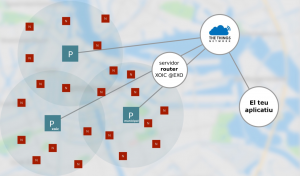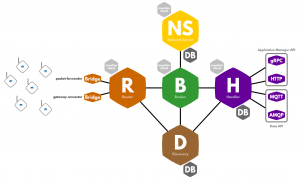This post is also available in: Español (Spanish) English
 A l’estiu del 2015, 10 entitats van col·locar passarel·les (antenes) de la tecnologia de radio LoRa a Amsterdam, i van apuntar-les a un servidor compartit per construir una xarxa comunitària per sensors i actuadors. Van triar LoRa perquè aleshores era (i podem dir que segueix sent) la tecnologia més oberta per construir una xarxa d’aquestes característiques. Amb un manifest que promet l’accés gratuït i sense discriminació a tothom i la proposta de desenvolupar els components de software de la xarxa sota condicions de programari lliure, de seguida van començar a sortir petits grups a centenars de ciutats d’arreu del món i es van posar a construir la seva comunitat local – així ho vam fer també a Barcelona i altres ciutats catalanes. Al gener del 2020 ja érem unes 100 mil persones en més de 700 ciutats, emetent uns 9 milions de missatges cada dia.
A l’estiu del 2015, 10 entitats van col·locar passarel·les (antenes) de la tecnologia de radio LoRa a Amsterdam, i van apuntar-les a un servidor compartit per construir una xarxa comunitària per sensors i actuadors. Van triar LoRa perquè aleshores era (i podem dir que segueix sent) la tecnologia més oberta per construir una xarxa d’aquestes característiques. Amb un manifest que promet l’accés gratuït i sense discriminació a tothom i la proposta de desenvolupar els components de software de la xarxa sota condicions de programari lliure, de seguida van començar a sortir petits grups a centenars de ciutats d’arreu del món i es van posar a construir la seva comunitat local – així ho vam fer també a Barcelona i altres ciutats catalanes. Al gener del 2020 ja érem unes 100 mil persones en més de 700 ciutats, emetent uns 9 milions de missatges cada dia.
Exemples d’usos de la xarxa
La xarxa es fa servir, entre moltes coses, per monitorar la qualitat de l’aire, l’aigua, els consums energètics de gas i d’aigua, per seguiment de vehicles i altres béns, per monitorar la humitat del terra i controlar el reg de precisió, el nivell d’aigua per preveure inundacions, controlar la ubicació d’animals, l’estat de l’enllumenat públic o el nivell d’ocupació de contenidors, l’estat de ponts, el control de fred o com a comptadors de persones o cotxes en l’espai públic.
La XOIC: aposta per cooperativitzar la xarxa oberta
Ara ja portem uns anys construint comunitat, fent tallers i sumant suports per part d’entitats padrines, ajuntaments, escoles, centres de recerca i altres empreses. El grup impulsor de la xarxa, a Barcelona, ens hem unit a la cooperativa femProcomuns per cooperativitzar la xarxa i per facilitar la seva consolidació. Qualsevol persona pot ser membre de la comunitat TTNCat a títol individual, però animem a les persones i entitats que vulguin implicar-se més intensament a fer-se sòcies de la cooperativa i aportar una contribució periòdica voluntària. Això els donarà veu i vot en la governança, contribuirà a la sostenibilitat del projecte i permetrà fer desplegaments més professionalitzats. A més, a mesura que creixin les aportacions s’aniran posant en marxa serveis mancomunats per les persones sòcies, com ara servidors NodeRed, ThingsBoard, Grafana, InfluxDB, Sentilo, Blynk, i altres que interessin a les persones sòcies.
La XOIC: desplegament col·lectiu
Podem distingir tres tipologies de passarel·les en funció de la seva titularitat:
La primera opció és la més habitual a la comunitat de The Things Network (TTN): persones i entitats adquireixen i col·loquen passarel·les LoRaWAN i les apunten al servidor de TTN més proper. Tothom és lliure de contribuir a fer la xarxa més gran afegint passarel·les. Així estan contribuint a ampliar la xarxa a Catalunya desenes de persones i entitats. És la manera com es va començar a construir TTN a Catalunya, i seguim animant la gent a afegir les seves passarel·les a la xarxa comunitària.
La segona opció, que es va iniciar a partir del 2018, consisteix en la compra i desplegament de passarel·les de forma col·lectiva. Així es va posar en marxa la XOIC, com un programa pilot amb el suport de l’Ajuntament de Barcelona i entitats padrines. Hi ha una dotzena de passarel·les adquirides i instal·lades per les padrines, i que són gestionades per la XOIC, sent la passarel·la propietat de la cooperativa. Ara s’estan afegint una serie de passarel·les amb el programa «Acull una gateway» (llegeix més aquí).
La tercera opció és la d’una passarel·la sota contracte. Diferents ajuntaments han contractat la XOIC per adquirir i instal·lar passarel·les en el seu municipi perquè la seva ciutadania tingui accés a la xarxa oberta. Aquestes passarel·les poden ser propietat dels ajuntaments però estan gestionades per la XOIC, per fer manteniment i assegurar el seu funcionament. La gestió la fa la XOIC amb el seu equip de mantenidors i col·laboradors locals.
La XOIC: aposta per col·laborar amb Guifi
Sempre que és possible intentem connectar les passarel·les de la XOIC amb la xarxa de Guifi.net. Aquesta comunitat és pionera en la construcció d’una xarxa comunitària i és la més gran de les xarxes d’Internet genèriques. Des del començament, la Fundació Guifi.net ha donat suport a TTNCat i a la XOIC amb recursos com servidors i llistes de correus, coneixement i la seva xarxa. És aquí on s’han pogut aprofitar bons emplaçaments per col·locar antenes de la XOIC a les mateixes teulades que ja disposen d’un node Guifi i així és possible que aquestes passarel·les es connectin a internet. I viceversa, les instal·lacions de XOIC serveixen per reforçar la xarxa Guifi allà on és possible.
Gràcies a la col·laboració amb la EXO (associació Expansió de la Xarxa Oberta) – un operador sense afany de lucre dins de Guifi.net –, la XOIC disposa d’un servidor dins de la xarxa Guifi per on s’enruta el tràfic d’aquestes passarel·les col·lectives i això permet un manteniment eficaç en remot.
La XOIC: portem el servidor de xarxa a Catalunya
Fins ara les dades s’envien, sempre xifrades, al servidor de xarxa europeu, ubicat a Amsterdam. És allà on les persones usuàries reclamen les dades dels seus dispositius i decideixen cap a quina aplicació enviar-les.
Fa temps que parlem de desplegar un servidor a Catalunya per tal de descentralitzar la xarxa i oferir un millor servei al nostre territori. El servidor de xarxa (LoRaWAN Network Server) consisteix en diferents components que formen la pila LoRaWAN. Hi ha el stack de TTN que és lliure (sota la llicencia MIT). També existeixen altres alternatives igualment lliures que implementen aquesta mateixa funcionalitat.
Tenim passarel·les que permeten enviar les dades a més d’un servidor de xarxa, la qual cosa pot ser una solució per fer proves i transitar cap al nou servidor. A part de les passarel·les col·lectives de la XOIC, cal el suport de la resta de propietaris de passarel·les de TTN per apuntar el seu tràfic de dades cap al servidor local.
Aquest diagrama mostra el conjunt de components principals del servidor de xarxa. Aquí s’explica en més detall l’arquitectura de la xarxa.
Ens calen mans per desplegar la xarxa en diferents comarques i municipis, per fer formació i capacitar-nos, per desenvolupar casos d’ús per resoldre necessitats socials, per gaudir de bons servidors de xarxa i d’aplicacions.
Si en voleu saber més, feu-vos sòcies, padrines, clientes o col·laboradores escriviu-nos a hola@xoic.coop i fem xarxa!


